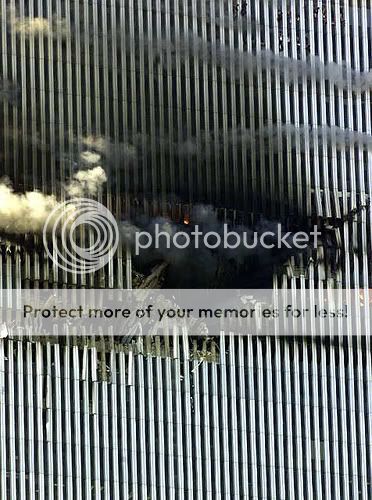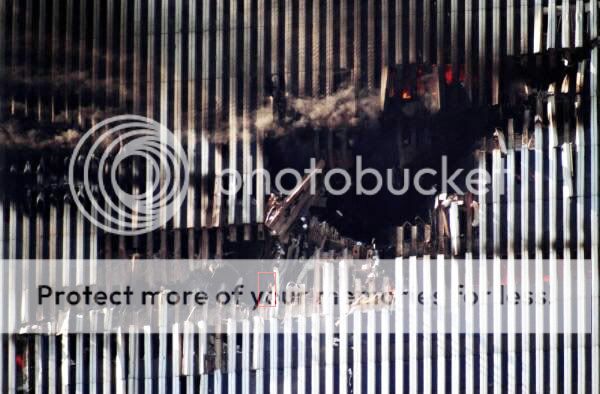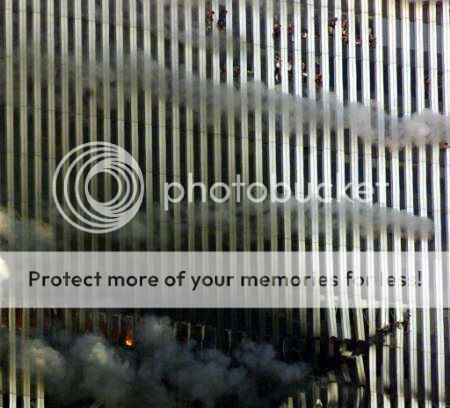It looks like you're using an Ad Blocker.
Please white-list or disable AboveTopSecret.com in your ad-blocking tool.
Thank you.
Some features of ATS will be disabled while you continue to use an ad-blocker.
share:
Whilst looking at some close ups of the impact of the plane on the north tower it was strange that many of the steel sections had 90% cuts and not
angled cuts as you would have expected with the angle of the wings.
Also at the extremity of the wing tips the steel was still sliced through even though the cut was very close to the floor slab where you would have expected the greatest resistance in the steel supports. How can that be, you would expect massive damage where the main baody of the plane hit but at the wing tips there would be very little mass or weight yet the steel supports were sliced through.
Is it possible that the tower structure could have been weakened before the plane hit and how do you account for clean 90% cuts through most of the steel frame. How does the edge of the wing slice through closely grouped steel supports that are just above the floor slab.
Also at the extremity of the wing tips the steel was still sliced through even though the cut was very close to the floor slab where you would have expected the greatest resistance in the steel supports. How can that be, you would expect massive damage where the main baody of the plane hit but at the wing tips there would be very little mass or weight yet the steel supports were sliced through.
Is it possible that the tower structure could have been weakened before the plane hit and how do you account for clean 90% cuts through most of the steel frame. How does the edge of the wing slice through closely grouped steel supports that are just above the floor slab.
The question you need to ask, is how could an aluminum plane take out a steel core?
Last time I looked, a piece of steel will crush aluminum. Hell, 5 pounds of steel can take down an Airliner. But an airliner can bring down a steel building?
Last time I looked, a piece of steel will crush aluminum. Hell, 5 pounds of steel can take down an Airliner. But an airliner can bring down a steel building?
It does seems strange, specailly when you figure most of the time a plane hits something the wings shear off. Ther are reports of a large piece of
wing being sheared off by hitting 1 light pole.
www.lasvegassun.com...
Here are some photos of usually what happens to wings when the hit an obsticle.
i114.photobucket.com...
i114.photobucket.com...
www.lasvegassun.com...
...It clipped a light pole in the National Car Rental parking lot, 2,760 feet past the runway, shearing off 18 feet of the left wing, then brushed the roof of the Avis Rent A Car building. The engines stalled.
Here are some photos of usually what happens to wings when the hit an obsticle.
i114.photobucket.com...
i114.photobucket.com...
hard to comment on when the picutres are not included in the post.
Please link the pics in question for review.
Please link the pics in question for review.
destructive force analysis is a weird science...
have you ever seen straw that has been shot into hardwood tree trunks in the aftermath of a tornado?
there is something to be said about kinetic energy contained within an objects momentum.
have you ever seen straw that has been shot into hardwood tree trunks in the aftermath of a tornado?
there is something to be said about kinetic energy contained within an objects momentum.
reply to post by NwestJagsfan
An education is a wonderful thing. Airplanes are not made out of aluminum. They are made out of aluminum alloys.
Alloys are metals that dipped or treated with another metal to make a totally different type of metal. The aluminum allows the weight to be light, the alloy allows for strenthening of the old metal.
Selecting the right alloy for a given application entails considerations of strength, ductility, formability, weldability and corrosion resistance to name a few.
5000 series are alloyed with magnesium, derive most of their strength from solution hardening, and can also be work hardened to strengths comparable to steel
Do a little research and you will understand more about basic chemistry.
en.wikipedia.org...
An education is a wonderful thing. Airplanes are not made out of aluminum. They are made out of aluminum alloys.
Alloys are metals that dipped or treated with another metal to make a totally different type of metal. The aluminum allows the weight to be light, the alloy allows for strenthening of the old metal.
Selecting the right alloy for a given application entails considerations of strength, ductility, formability, weldability and corrosion resistance to name a few.
5000 series are alloyed with magnesium, derive most of their strength from solution hardening, and can also be work hardened to strengths comparable to steel
Do a little research and you will understand more about basic chemistry.
en.wikipedia.org...
1. Photo showing what happens when a thin aluinum airframe hits some small trees at medium speed.
i114.photobucket.com...
So what do you think would happen to an aluminum airframe hitting a reinforced wall?
2. Photos of holes in a 767 aluminum airframe casued by small birds hitting the aircraft.
i114.photobucket.com...
i114.photobucket.com...
i114.photobucket.com...
i114.photobucket.com...
[edit on 15-11-2007 by ULTIMA1]
i114.photobucket.com...
So what do you think would happen to an aluminum airframe hitting a reinforced wall?
2. Photos of holes in a 767 aluminum airframe casued by small birds hitting the aircraft.
i114.photobucket.com...
i114.photobucket.com...
i114.photobucket.com...
i114.photobucket.com...
[edit on 15-11-2007 by ULTIMA1]
Originally posted by magicmushroom
Is it possible that the tower structure could have been weakened before the plane hit and how do you account for clean 90% cuts through most of the steel frame. How does the edge of the wing slice through closely grouped steel supports that are just above the floor slab.
I was thinking maybe the perimeter columns terminated almost level to the floors, so when the bolts connecting then sheared, the failure would be near the floor anyway. Not so:
I shouldn't have needed to look that up knowing that those columns terminated in a staggered fashion, 1 out of 3 terminating on each floor.
I wouldn't really be surprised if they cut/weakened the outer facade for the planes to enter. Even NIST's models showed that, realistically, Flight 175's parts should not have been coming out of the other side of the building (ie engine, and... nose cone?!? or any part of the fuselage), so NIST decided that their models were wrong and ramped up the plane/weakened the structure to make it work.
Thats not an airframe....thats the skin of the plane. I never said anything about that being an alloy. The structural skeleton of an airliner is
made of aluminum alloy.
If I told you that water can punch through steel, would you accuse me of lying?
Its weird science out there.
Its weird science out there.
reply to post by ULTIMA1
Is it your view that the bird, flying at its normal speed of betwen 20 and 40mph, could puncture the skin of a stationary aircraft?
If not, how do you explain the fact it punctured the skin of an aircraft travelling at, say, 500+mph?
2. Photos of holes in a 767 aluminum airframe casued by small birds hitting the aircraft.
Is it your view that the bird, flying at its normal speed of betwen 20 and 40mph, could puncture the skin of a stationary aircraft?
If not, how do you explain the fact it punctured the skin of an aircraft travelling at, say, 500+mph?
Originally posted by deltaboy
If I told you that water can punch through steel, would you accuse me of lying?.
But an aluminum airframe is not going to stand up to punching through a reinforced concrete wall or hitting steel beams.
If you look at the Purdue animation of the plane hitting the WTC you will see the airframe being shredded as soon as it hits the steel beams.



Imagine the plane leaving a mark like cartoons when punching through walls.
Originally posted by ULTIMA1
But an aluminum airframe is not going to stand up to punching through a reinforced concrete wall or hitting steel beams.
The Towers are not a block of steel, it has rooms inside it. Kind of like outer hull and inner hull. Don't expect the planes to bounce off, especially when you consider both mass and velocity.
Originally posted by deltaboy
Imagine the plane leaving a mark like cartoons when punching through walls.
Hard to believe when the nose is just graphite composite and the airframe is thin aluminum.
Originally posted by deltaboy
If I told you that water can punch through steel, would you accuse me of lying?
Its weird science out there.
Yes but the water leaves the nossle at a speed of more than 900mph in most water jet cutters, and the latest models have a jet speed of mach 3.
Originally posted by lostcoyote
destructive force analysis is a weird science...
have you ever seen straw that has been shot into hardwood tree trunks in the aftermath of a tornado?
A little education...Velocity is not what makes straw stick in trees in a tornado. In fact there is no explanation for it only theories. One theory is that the tress bend in the wind causing cracks that the straw flies into. Another theory has to do with electro magnetism or something.
Destructive force is not a weird science and you can predict what would happen to a particular object on impact.
Think about this, take a piece of steel and slam it with a piece of aluminum as hard as possible, which do you think would win? Try it the other way hit aluminum with steel, do you think the results would be different?
If you do then you don't understand how materials work during impacts. Or imagine the plane standing still and being slammed by the WTC at 400MPH. The harder denser object, whether it's the one moving or not, will always win.
Originally posted by Chemicalbrother
Yes but the water leaves the nossle at a speed of more than 900mph in most water jet cutters, and the latest models have a jet speed of mach 3.
And I would like to point out that the planes weren't exactly staying still either. How fast were they going anyways? 300 mph or more?
reply to post by ANOK
ANOK
Same questions to you that I asked ULTIMA1 earlier.
You'll recall that he linked to images of a plane's skin having been punctured by a bird in flight.
Given your earlier argument that velocity is not a factor, how would you answer the following?
1. Would the bird have punctured the skin of a stationary plane if it were flying at between 20 and 40mph?
2. If not, why does it puncture the skin when the plane is travelling at ~500mph?
ANOK
Same questions to you that I asked ULTIMA1 earlier.
You'll recall that he linked to images of a plane's skin having been punctured by a bird in flight.
Given your earlier argument that velocity is not a factor, how would you answer the following?
1. Would the bird have punctured the skin of a stationary plane if it were flying at between 20 and 40mph?
2. If not, why does it puncture the skin when the plane is travelling at ~500mph?
Originally posted by deltaboy
And I would like to point out that the planes weren't exactly staying still either. How fast were they going anyways? 300 mph or more?
300 or 400 is still a lot different then 900 mph. Also figure the size of the planes and the impact areas. Water jets use a very small impact area.
new topics
-
Comcast dumping MSNBC
Mainstream News: 1 hours ago -
President-elect TRUMP Picks MATT GAETZ for his ATTORNEY GENERAL - High Level PANIC Ensues.
2024 Elections: 5 hours ago -
Mike Tyson returns 11-15-24
World Sports: 10 hours ago -
HHS Spent Hundreds of Millions of Dollars on DEI Initiatives Under Biden, Watchdog Finds
US Political Madness: 11 hours ago -
Breaking: FBI Agents Raid Polymarket CEO After Betting Site Predicts Trump Win
General Conspiracies: 11 hours ago
top topics
-
Breaking: FBI Agents Raid Polymarket CEO After Betting Site Predicts Trump Win
General Conspiracies: 11 hours ago, 18 flags -
The Guardian quits Elon Musk's X social media platform
Mainstream News: 12 hours ago, 16 flags -
US warship Edsall Lost after Pearl Harbor Attack Found 80 Years Later ... by Accident
Mainstream News: 15 hours ago, 14 flags -
Thune selected as Senate Republican Leader
US Political Madness: 14 hours ago, 13 flags -
HHS Spent Hundreds of Millions of Dollars on DEI Initiatives Under Biden, Watchdog Finds
US Political Madness: 11 hours ago, 11 flags -
President-elect TRUMP Picks MATT GAETZ for his ATTORNEY GENERAL - High Level PANIC Ensues.
2024 Elections: 5 hours ago, 7 flags -
WATCH LIVE: US Congress hearing on UFOs, unidentified anomalous phenomena
Aliens and UFOs: 17 hours ago, 7 flags -
Band of Brothers 2001 Classic
Television: 14 hours ago, 7 flags -
Mike Tyson returns 11-15-24
World Sports: 10 hours ago, 4 flags -
Comcast dumping MSNBC
Mainstream News: 1 hours ago, 4 flags
active topics
-
Breaking: FBI Agents Raid Polymarket CEO After Betting Site Predicts Trump Win
General Conspiracies • 19 • : billxam1 -
How can you defend yourself when the police will not tell you what you did?
Posse Comitatus • 63 • : Freeborn -
60s-70s Psychedelia
Music • 52 • : Flyingclaydisk -
Mike Tyson returns 11-15-24
World Sports • 14 • : angelchemuel -
President-elect TRUMP Picks MATT GAETZ for his ATTORNEY GENERAL - High Level PANIC Ensues.
2024 Elections • 36 • : putnam6 -
Comcast dumping MSNBC
Mainstream News • 1 • : WeMustCare -
Judge’s Dismissal of Classified Document Case Against Trump Explained
Other Current Events • 19 • : WeMustCare -
Thune selected as Senate Republican Leader
US Political Madness • 69 • : yuppa -
Post A Funny (T&C Friendly) Pic Part IV: The LOL awakens!
General Chit Chat • 7769 • : MRTrismegistus -
WATCH LIVE: US Congress hearing on UFOs, unidentified anomalous phenomena
Aliens and UFOs • 33 • : WeMustCare

